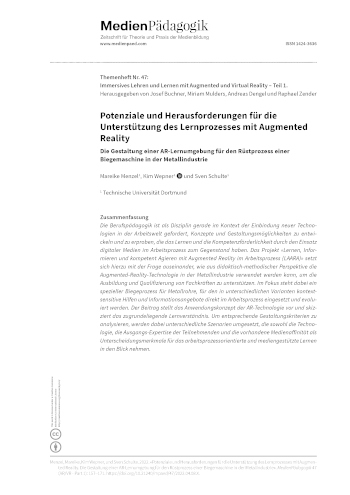Abstract
Particularly in the context of the implementation of new technologies in the world of work, vocational pedagogy as a discipline is challenged to develop and evaluate concepts and approaches that are coping with learning and addressing the enhancement of competence development in the work process by digital media. The «LAARA»-project tackles the question of how augmented reality technology can be used from a didactic-methodological perspective to support the training and qualification of skilled workers in the metal industry. The focus is set on a special bending process for metal pipes, for which context-sensitive aids and information offers are used and evaluated in different scenarios directly in the work process. The article outlines the application concept of AR technology and the learning approach. In order to analyze the corresponding shaping criteria, different settings are implemented that take into account the technology, the initial expertise of the participants and the existing media affinity as distinctive features for work process-oriented and media-supported learning.
References
Becker, Fred, Vanessa Friske, Cornelia Meurer, Yves Ostrowski, Sascha Piezonka, und Ellena Werning. 2010. «Einsatz des Problemorientierten Lernens in der betriebswirtschaftlichen Hochschullehre.» WiSt – Wirtschaftswissenschaftliches Studium 8, 366–71. https://doi.org/10.15358/0340-1650-2010-8-366.
Bundesministerium für Bildung und Forschung. 2021. eQualification 2021. Lernen und Beruf digital verbinden – Gamification. Projektband des Förderbereiches ‹Digitale Medien in der beruflichen Bildung›, herausgegeben von Bundesministerium für Bildung und Forschung (BMBF). https://www.bmbf.de/SharedDocs/Publikationen/de/bmbf/3/31653_equalification_2021.pdf.
Dörner, Dietrich. 1987. Problemlösen als Informationsverarbeitung. Stuttgart: Kohlhammer.
Dörner, Ralf, Wolfgang Broll, Paul Grimm, und Hermann Jung. 2019. Augmented Reality (VR/AR). Grundlagen und Methoden der Virtuellen und Augmentierten Realität. 2. Aufl. Wiesbaden: Springer Vieweg. https://doi.org/10.1007/978-3-662-58861-1.
Euler, Dieter, und Eckart Severing. 2019. Berufsbildung für eine digitale Arbeitswelt. Fakten, Gestaltungsfelder, offene Fragen. Gütersloh: Bertelsmann Stiftung. https://doi.org/10.11586/2019003.
Fehling, Christian Dominic. 2017a. «Erweiterte Lernwelten für die berufliche Bildung. Augmented Reality als Perspektive». In Lernen in Virtuellen Räumen: Perspektiven des Mobilen Lernens, herausgegeben von Frank Thissen. Berlin: De Gruyter Saur. 125–42. https://doi.org/10.1515/9783110501131-009.
Fehling, Christian Dominic. 2017b. «Neue Lehr- und Lernformen in der Ausbildung 4.0. Social Augmented Reality in der Druckindustrie». Berufsbildung in Wissenschaft und Praxis: Berufsbildung 4.0. (2): 30–3. https://nbn-resolving.org/urn:nbn:de:0035-bwp-17230-7.
Fischer, Renate. 2021. Problemorientiertes Lernen in Theorie und Praxis. Stuttgart: Kohlhammer.
Hermann, Ralf, und Hannelore Kress. 2019. «Gestaltungsfelder beruflicher Bildung im digitalen Wandel». In Berufsbildung International Digitalisierung, herausgegeben von DLR Projektträger, 45-50. Bonn. https://www.berufsbildung-international.de/files/IBB_Publikation_02-19_Digitalisierung_web.pdf.
Kolb, Dieter. 1985. Learning Style Inventory. Boston: McBer and Company.
Lee, Elinda Ai-Lim, Kok Wai Wong, und Chun Che Fung. 2010. «Learning with virtual reality: its effects on students with different learning styles». Transactions on Edutainment IV, herausgegeben von Zhigeng Pan, Adrian David Cheok, Wolfgang Müller, Xiaopeng Zhang, und Kevin Wong, 79–90. Berlin: Springer. https://doi.org/10.1007/978-3-642-14484-4_8.
Radianti, Jaziar, Tim A. Majchrzak, Jennifer Fromm, Isabell Wohlgenannt. 2020. «A Systematic Review of Immersive Virtual Reality Applications for Higher Education: Design Elements, Lessons Learned, and Research Agenda». Computers & Education 147 (April): 103778. https://doi.org/10.1016/j.compedu.2019.103778.
Sachse, Uwe, und Frederic Graeb. 2019. «Potentiale von Augmented Reality in der beruflichen Aus- und Weiterbildung. Entwicklung und Prototyping AR App Robotik». In Berufsbildung International Digitalisierung, herausgegeben von DLR Projektträger, 32–7. Bonn. https://www.berufsbildung-international.de/files/IBB_Publikation_02-19_Digitalisierung_web.pdf.
Thomas, Oliver, Helmut Niegemann, und Dirk Metzger, Hrsg. 2018. Digitalisierung in der Aus- und Weiterbildung. Virtual und Augmented Reality für Industrie 4.0. Wiesbaden: Springer Gabler. https://doi.org/10.1007/978-3-662-56551-3.
Zender, Raphael, Matthias Weise, Markus von der Heyde, und Heinrich Söbke. 2018. «Lehren und Lernen mit VR und AR – Was wird erwartet? Was funktioniert?». In Proceedings of DeLFI Workshops 2018 co-located with 16th e-Learning Conference of the German Computer Society (DeLFI 2018) Frankfurt, herausgegeben von Daniel Schiffner. http://ceur-ws.org/Vol-2250/WS_VRAR_paper5.pdf.

